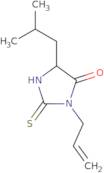Albutoin
CAS: 830-89-7
Ref. 3D-FA162332
| 1g | Descatalogado | ||
| 50mg | Descatalogado | ||
| 100mg | Descatalogado | ||
| 250mg | Descatalogado | ||
| 500mg | Descatalogado |
Información del producto
- 5-(2-Methylpropyl)-3-(prop-2-en-1-yl)-2-sulfanylideneimidazolidin-4-one
- 3-Allyl-5-isobutyl-2-thiohydantoin
- 3-Allyl-5-isobutyl-2-thioxo-4-imidazolidinon
- 3-Allyl-5-isobutyl-2-thioxo-imidazolidin-4-one
- 3-Allyl-5-isobutyl-2-thioxoimidazolidin-4-one
- 4-Imidazolidinone, 5-(2-methylpropyl)-3-(2-propen-1-yl)-2-thioxo-
- 4-Imidazolidinone, 5-(2-methylpropyl)-3-(2-propenyl)-2-thioxo-
- 5-(2-Methylpropyl)-3-(2-propen-1-yl)-2-thioxo-4-imidazolidinone
- 5-(2-Methylpropyl)-3-(2-propenyl)-2-thioxo-4-imidazolidinone
- 5-(2-Methylpropyl)-3-Prop-2-En-1-Yl-2-Thioxoimidazolidin-4-One
- Ver más sinónimos
- Albutoin [USAN:INN]
- Albutoina
- Albutoina [INN-Spanish]
- Albutoine
- Albutoine [INN-French]
- Albutoinum
- Albutoinum [INN-Latin]
- Bax 422 Z
- Bax 422Z
- Brn 0163719
- Coord
- Euprax
- Hydantoin, 3-allyl-5-isobutyl-2-thio-
- Unii-475Ngr2Dc1
- 4-24-00-01139 (Beilstein Handbook Reference)
Albutoin is a drug that has the chemical structure of an organic compound. It is the sodium salt of butyl-2,3-diamino-6-hydroxybenzoate and is a reaction product of the citric acid cycle. Albutoin has been shown to have potential as a cancer treatment for prostate cancer cells by inhibiting protein synthesis. This drug also has a redox potential, which may be due to its ability to transfer electrons from one molecule to another. Albutoin binds to substrate molecules in biological systems and forms a coordination complex with them. The binding of albutoin to these substrate molecules is dependent on the pH level and can be inhibited by chelating agents such as EDTA or ethylene diamine tetraacetic acid. Albutoin also interacts with liver cells and neutral ph levels, which may be due to its polymeric matrix nature.





